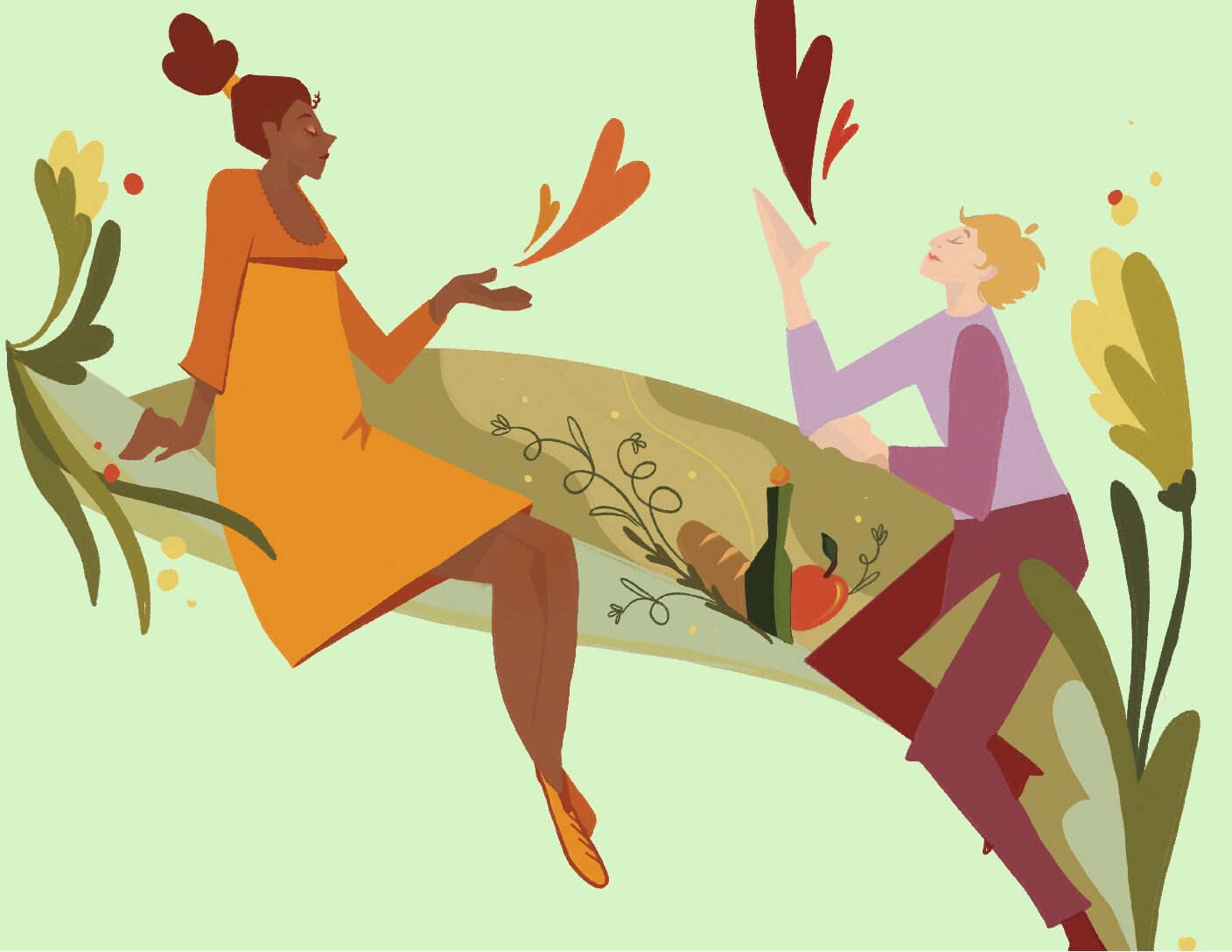Connecting with others through the universal language—a perfect meal
Yasmine Elsayed (she/her) // Contributor
Lucy Benson (she/her) // Illustrator
Food is the great equalizer. It transcends borders, languages and backgrounds, forging connections between individuals from diverse cultures. It is a universal language that speaks to the heart, inviting us to share our stories, traditions, and humanity, exploring how we connect with others through food, and sharing stories about food’s profound importance in different cultures. From grand feasts to humble family meals, food is a unifying force that brings us together.
Food also acts as a powerful form of storytelling. It provides a medium to share personal narratives and cultural histories. When we cook a dish from childhood, for example, or prepare a recipe passed down through generations, we are not just making a meal; we share a piece of our family’s history. Through these stories, we connect with others on a deep, personal level, making each meal more enjoyable than the one before it.
Food has a remarkable ability to challenge and break down stereotypes. Often, stereotypes and prejudices arise from ignorance or misunderstandings. However, when we sit down to share a meal with someone from a different culture, we can see beyond those preconceived notions. For example, enjoying a traditional Middle Eastern meal can shatter stereotypes about the region, revealing its rich culinary heritage rather than focusing on political or social issues. For many communities, their food is a source of pride and a way to preserve their cultural heritage. Passing down traditional recipes from one generation to the next helps keep these culinary traditions alive. When communities share their food with others, it is an opportunity to showcase their cultural identity and connect with people who may not be familiar with their heritage.
Through my own experiences, I find it wonderful when a friend shares one of their family recipes with me. Whenever I decide to make that dish, I remember their story and how it came about in their culture. I often see similarities between my culture and others. For example, in Middle Eastern countries it is customary to gather with the family to share a meal every week or so. There is an unspoken rule that after dinner we have to drink tea and eat dessert. Occasions like these are lively and in the moment, and they remind us of what the term family means and teach us humility.
Globalization makes many cuisines no longer permanent to a specific region. Through immigration and media, one can try all sorts of food from different countries. For example, in 2016 the Vancouver City Councillors voted to name the eight-block stretch of Commercial Drive as Little Italy–honoring the Italian community that had settled there since the 1930s.
However, globalization and media can have negative effects on cultural dishes as well, with trends sometimes impacting the authenticity of a specific dish. It is estimated in New York City, in the States, 85 per cent of Japanese cuisine is neither owned nor run by Japanese people. While trends help popularize, they can also take away the labour of love a dish went through to be created. It is essential to remember where the food comes from, and understand that generations of people in certain cultures spent years developing and perfecting certain dishes. There is a fine line between appreciating a culture and cultural appropriation. Because of social media and its craze around specific cultures, things can get out of hand. In 2017, a mother threw her daughter a Japanese-themed tea party for her birthday and dressed her in Japanese geisha attire, sparking debate among X (formerly known as Twitter) users. One commenter said that since the makeup was meant to be reflective of traditional geisha makeup, it counted as yellowface. Another defended the girl, saying, “I am Japanese, in Japan at this very moment… The picture is not ‘yellowface’ they are not making fun of Asians. In fact, it looks like they put extra care and research into their work.” The line between celebrating and appreciating culture or appropriating it is still blurry, and this incident faded from public attention without resolution. In another example, Vogue has been known for “popularizing” culture-specific attire, for instance, Kendall Jenner’s afro in one of her photoshoots in 2018. Due to this incident, cultural appropriation returned to the public eye yet again.
The question lies in how we distinguish between appreciation and appropriation. Appreciation is when one takes the time to understand and educate oneself about another culture — making an effort to broaden one’s perspective and connect with others. Appropriation, on the other hand, is taking a piece of someone’s culture and claiming it as your own or trying to benefit from it without giving credit. Recently, many Instagram Reels and TikToks have been popping up where people attempt to cook Middle Eastern dishes and name them something completely different, known as the “Middle Eastern Diet.” Some believe that it is incredibly and undeniably healthy. The diet includes foods like whole grains, fruits, vegetables, seafood, beans, and nuts, which doesn’t fully represent Middle Eastern food. You can eat healthy, but this is not exclusive to only the Middle East, and ‘clean eating’ is a more Westernized concept than most people think. Middle Eastern food relies a lot on oil, ghee and spices like Egyptian shawarma or Lebanese arayes and much more. Appreciating cultures takes time and effort; appropriation takes away from the culture. Where food fits into this discussion still seems to be under debate, but undeniably, food sharing done right is a medium that can bring people together, through language or cultural barriers.





